Fabrication of Stable Cu-Ce Catalyst with Active Interfacial Sites for NOx Elimination by Flame Spray Pyrolysis
Abstract
:1. Introduction
2. Results and Discussion
2.1. Catalytic Performances
2.2. Crystal Structure and Morphology Analysis
2.3. Oxygen Species Analysis
2.3.1. Raman
2.3.2. CO-TPR
2.3.3. Oxygen Storage Capacity
2.3.4. NO Pulse
2.4. Surface Species Identification
2.4.1. N2O Pulse Chemisorption
2.4.2. XPS
3. Materials and Methods
3.1. Materials Preparation
3.2. Catalytic Performance
3.3. Characterizations
4. Conclusions
Author Contributions
Funding
Data Availability Statement
Conflicts of Interest
References
- Agathokleous, E.; Sicard, P. Editorial Overview: Current and Future Challenges of Air Pollution. Curr. Opin. Environ. Sci. Health 2021, 21, 100246. [Google Scholar] [CrossRef]
- De Vries, W. Impacts of Nitrogen Emissions on Ecosystems and Human Health: A Mini Review. Curr. Opin. Environ. Sci. Health 2021, 21, 100249. [Google Scholar] [CrossRef]
- Khivantsev, K.; Vargas, C.G.; Tian, J.; Kovarik, L.; Jaegers, N.R.; Szanyi, J.; Wang, Y. Economizing on Precious Metals in Three-Way Catalysts: Thermally Stable and Highly Active Single-Atom Rhodium on Ceria for NO Abatement under Dry and Industrially Relevant Conditions. Angew. Chem. Int. Ed. 2021, 60, 391–398. [Google Scholar] [CrossRef] [PubMed]
- Cheng, X.; Xiao, X.; Yin, Y.; Wang, J.; Qiao, W.; Ling, L. Ammonia-Free Selective Catalytic Reduction of NO at Low Temperature on Melamine Impregnated MnOx–CeO2/Carbon Aerogels. Ind. Eng. Chem. Res. 2021, 60, 13233–13242. [Google Scholar] [CrossRef]
- Roy, S.; Marimuthu, A.; Hegde, M.; Madras, G. High Rates of NO and N2O Reduction by CO, CO and Hydrocarbon Oxidation by O2 over Nano Crystalline Ce0.98Pd0.02O2−δ: Catalytic and Kinetic Studies. Appl. Catal. B Environ. 2007, 71, 23–31. [Google Scholar] [CrossRef]
- Takigawa, A.; Matsunami, A.; Arai, N.; Peng, Y.Z. Effects of CO and H2 on the Formation of N2O via Catalytic NO Reduction. Energy 2005, 30, 475–484. [Google Scholar] [CrossRef]
- Ravishankara, A.R.; John, S.D.; Robert, W.P. Nitrous Oxide (N2O): The Dominant Ozone-Depleting Substance Emitted in the 21st Century. Science 2009, 326, 123–125. [Google Scholar] [CrossRef] [Green Version]
- Roy, S.; Hegde, M.; Madras, G. Catalysis for NOx Abatement. Appl. Energy 2009, 86, 2283–2297. [Google Scholar] [CrossRef]
- Ueda, K.; Tsuji, M.; Ohyama, J.; Satsuma, A. Tandem Base-Metal Oxide Catalyst: Superior NO Reduction Performance to the Rh Catalyst in NO–C3H6–CO–O2. ACS Catal. 2019, 9, 2866–2869. [Google Scholar] [CrossRef]
- Hu, Q.; Cao, K.; Lang, Y.; Chen, R.; Chu, S.; Jia, L.; Yue, J.; Shan, B. Improved NO–CO Reactivity of Highly Dispersed Pt Particles on CeO2 Nanorod Catalysts Prepared by Atomic Layer Deposition. Catal. Sci. Technol. 2019, 9, 2664–2672. [Google Scholar] [CrossRef]
- Cheng, X.; Zhang, X.; Su, D.; Wang, Z.; Chang, J.; Ma, C. NO Reduction by CO over Copper Catalyst Supported on Mixed CeO2 and Fe2O3: Catalyst Design and Activity Test. Appl. Catal. B Environ. 2018, 239, 485–501. [Google Scholar] [CrossRef]
- Wang, Q.; Li, G.; Zhao, B.; Shen, M.; Zhou, R. The Effect of La Doping on the Structure of Ce0.2Zr0.8O2 and the Catalytic Per-Formance of Its Supported Pd-Only Three-Way Catalyst. Appl. Catal. B Environ. 2010, 101, 150–159. [Google Scholar] [CrossRef]
- Yao, X.; Xiong, Y.; Zou, W.; Zhang, L.; Wu, S.; Dong, X.; Gao, F.; Deng, Y.; Tang, C.; Chen, Z.; et al. Correlation Between the Physicochemical Properties and Catalytic Performances of CexSn1–xO2 Mixed Oxides for NO Reduction by CO. Appl. Catal. B Environ. 2014, 144, 152–165. [Google Scholar] [CrossRef]
- Wu, Y.; Li, D.; Lu, J.; Xie, S.; Dong, L.; Fan, M.; Li, B. LaMnO3-La2CuO4 Two-Phase Synergistic System with Broad Active Window in NOx Efficient Reduction. Mol. Catal. 2020, 493, 111111. [Google Scholar] [CrossRef]
- Schön, A.; Dacquin, J.-P.; Granger, P.; Dujardin, C. Non Stoichiometric La1-YFeO3 Perovskite-Based Catalysts As Alternative to Commercial Three-Way-Catalysts?—Impact of Cu and Rh Doping. Appl. Catal. B Environ. 2018, 223, 167–176. [Google Scholar] [CrossRef]
- Guo, S.; Zhang, G.; Han, Z.-K.; Zhang, S.; Sarker, D.; Xu, W.W.; Pan, X.; Li, G.; Baiker, A. Synergistic Effects of Ternary PdO–CeO2–OMS-2 Catalyst Afford High Catalytic Performance and Stability in the Reduction of NO With CO. ACS Appl. Mater. Interfaces 2021, 13, 622–630. [Google Scholar] [CrossRef] [PubMed]
- Shi, X.; Chu, B.; Wang, F.; Wei, X.; Teng, L.; Fan, M.; Li, B.; Dong, L.; Dong, L. Mn-Modified CuO, CuFe2O4, and γ-Fe2O3 Three-Phase Strong Synergistic Coexistence Catalyst System for NO Reduction by CO With a Wider Active Window. ACS Appl. Mater. Interfaces 2018, 10, 40509–40522. [Google Scholar] [CrossRef]
- Carollo, G.; Garbujo, A.; Xin, Q.; Fabro, J.; Cool, P.; Canu, P.; Glisenti, A. CuO/0.5Sr0.5CoO3 Nanocomposites in TWC. Appl. Catal. B Environ. 2019, 255, 117753. [Google Scholar] [CrossRef]
- Hong, W.-J.; Ueda, M.; Iwamoto, S.; Hosokawa, S.; Wada, K.; Kanai, H.; Deguchi, H.; Inoue, M. Effect of Fe Content on Physical Properties of BaO–CeOx–FeOy Catalysts for Direct NO Decomposition. Appl. Catal. B Environ. 2011, 106, 142–148. [Google Scholar] [CrossRef] [Green Version]
- Dong, L.; Zhang, B.; Tang, C.; Li, B.; Zhou, L.; Gong, F.; Sun, B.; Gao, F.; Dong, L.; Chen, Y. Influence of CeO2 Modification on the Properties of Fe2O3–Ti0.5Sn0.5O2 Catalyst for NO Reduction by CO. Catal. Sci. Technol. 2014, 4, 482–493. [Google Scholar] [CrossRef]
- Schmitt, R.; Nenning, A.; Kraynis, O.; Korobko, R.; Frenkel, A.I.; Lubomirsky, I.; Haile, S.M.; Rupp, J.L.M. A Review of Defect Structure and Chemistry in Ceria and Its Solid Solutions. Chem. Soc. Rev. 2020, 49, 554–592. [Google Scholar] [CrossRef] [Green Version]
- Mastelaro, V.; Briois, V.; de Souza, D.P.; Silva, C.L. Structural Studies of a ZrO2–CeO2 Doped System. J. Eur. Ceram. Soc. 2003, 23, 273–282. [Google Scholar] [CrossRef]
- Lambrou, P.S.; Savva, P.G.; Fierro, J.L.G.; Efstathiou, A.M. The Effect of Fe on the Catalytic Behavior of Model Pd-Rh/CeO2-Al2O3 Three-Way Catalyst. Appl. Catal. B Environ. 2007, 76, 375–385. [Google Scholar] [CrossRef]
- Vidmar, P.; Fornasiero, P.; Kašpar, J.; Gubitosa, G.; Graziani, M. Effects of Trivalent Dopants on the Redox Properties of Ce0.6Zr0.4O2Mixed Oxide. J. Catal. 1997, 171, 160–168. [Google Scholar] [CrossRef]
- Jia, L.; Shen, M.; Wang, J.; Chu, X.; Wang, J.; Hu, Z. Redox Behaviors and Structural Characteristics of Mn0.1Ce0.9Ox and Mn0.1Ce0.6Zr0.3Ox. J. Rare Earths 2008, 26, 523–527. [Google Scholar] [CrossRef]
- Zhang, L.; Spezzati, G.; Muravev, V.; Verheijen, M.A.; Zijlstra, B.; Filot, I.A.W.; Su, Y.-Q.; Chang, M.-W.; Hensen, E.J.M. Improved Pd/CeO2 Catalysts for Low-Temperature NO Reduction: Activation of CeO2 Lattice Oxygen by Fe Doping. ACS Catal. 2021, 11, 5614–5627. [Google Scholar] [CrossRef] [PubMed]
- Martínez-Arias, A.; Fernández-García, M.; Gálvez, O.; Coronado, J.M.; Anderson, J.A.; Conesa, J.C.; Soria, J.; Munuera, G. Comparative Study on Redox Properties and Catalytic Behavior for CO Oxidation of CuO/CeO2 and CuO/ZrCeO4 Catalysts. J. Catal. 2000, 195, 207–216. [Google Scholar] [CrossRef] [Green Version]
- Hornés, A.; Hungría, A.B.; Bera, P.; Cámara, A.L.; Fernández-García, M.; Martínez-Arias, A.; Barrio, L.; Estrella, M.; Zhou, G.; Fonseca, J.J.; et al. Inverse CeO2/CuO Catalyst As an Alternative to Classical Direct Configurations for Preferential Oxidation of CO in Hydrogen-Rich Stream. J. Am. Chem. Soc. 2010, 132, 34–35. [Google Scholar] [CrossRef]
- Perin, G.; Fabro, J.; Guiotto, M.; Xin, Q.; Natile, M.M.; Cool, P.; Canu, P.; Glisenti, A. Cu@LaNiO3 Based Nanocomposites in TWC Applications. Appl. Catal. B Environ. 2017, 209, 214–227. [Google Scholar] [CrossRef]
- Dong, L.; Zhang, L.; Sun, C.; Yu, W.; Zhu, J.; Liu, L.; Liu, B.; Hu, Y.; Gao, F.; Dong, L.; et al. Study of the Properties of CuO/VOx/Ti0.5Sn0.5O2 Catalysts and Their Activities in NO + CO Reaction. ACS Catal. 2011, 1, 468–480. [Google Scholar] [CrossRef]
- Koirala, R.; Pratsinis, S.E.; Baiker, A. Synthesis of Catalytic Materials in Flames: Opportunities and Challenges. Chem. Soc. Rev. 2016, 45, 3053–3068. [Google Scholar] [CrossRef] [PubMed] [Green Version]
- Teoh, W.Y.; Amal, R.; Mädler, L. Flame Spray Pyrolysis: An Enabling Technology for Nanoparticles Design and Fabrication. Nanoscale 2010, 2, 1324–1347. [Google Scholar] [CrossRef] [PubMed]
- Christensen, J.M.; Deiana, D.; Grunwaldt, J.-D.; Jensen, A.D. Ceria Prepared by Flame Spray Pyrolysis as an Efficient Catalyst for Oxidation of Diesel Soot. Catal. Lett. 2014, 144, 1661–1666. [Google Scholar] [CrossRef]
- Michalow-Mauke, K.A.; Lu, Y.; Kowalski, K.; Graule, T.; Nachtegaal, M.; Kröcher, O.; Ferri, D. Flame-Made WO3/CeOx-TiO2 Catalysts for Selective Catalytic Reduction of NOx by NH3. ACS Catal. 2015, 5, 5657–5672. [Google Scholar] [CrossRef]
- Kydd, R.; Teoh, W.Y.; Wong, K.; Wang, Y.; Scott, J.; Zeng, Q.-H.; Yu, A.-B.; Zou, J.; Amal, R. Flame-Synthesized Ceria-Supported Copper Dimers for Preferential Oxidation of CO. Adv. Funct. Mater. 2009, 19, 369–377. [Google Scholar] [CrossRef]
- Yang, F.; Liu, M.; Chen, X.; Xu, Z.; Zhao, H. Simultaneous Control over Lattice Doping and Nanocluster Modification of a Hybrid CuOx/TiO2 Photocatalyst during Flame Synthesis for Enhancing Hydrogen Evolution. Sol. RRL 2018, 2, 1800215. [Google Scholar] [CrossRef]
- Zhang, Z.; Yu, J.; Zhang, J.; Ge, Q.; Xu, H.; Dallmann, F.; Dittmeyer, R.; Sun, J. Tailored Metastable Ce–Zr Oxides with Highly Distorted Lattice Oxygen for Accelerating Redox Cycles. Chem. Sci. 2018, 9, 3386–3394. [Google Scholar] [CrossRef] [Green Version]
- Lopes, D.; Zotin, F.; Palacio, L.A. Copper-Nickel Catalysts from Hydrotalcite Precursors: The Performance in NO Reduction by CO. Appl. Catal. B Environ. 2018, 237, 327–338. [Google Scholar] [CrossRef]
- Liu, T.; Yao, Y.; Wei, L.; Shi, Z.; Han, L.; Yuan, H.; Li, B.; Dong, L.; Wang, F.; Sun, C. Preparation and Evaluation of Copper–Manganese Oxide as a High-Efficiency Catalyst for CO Oxidation and NO Reduction by CO. J. Phys. Chem. C 2017, 121, 12757–12770. [Google Scholar] [CrossRef]
- Wang, Y.; Jiang, Q.; Xu, L.; Han, Z.-K.; Guo, S.; Li, G.; Baiker, A. Effect of the Configuration of Copper Oxide–Ceria Catalysts in NO Reduction With CO: Superior Performance of a Copper–Ceria Solid Solution. ACS Appl. Mater. Interfaces 2021, 13, 61078–61087. [Google Scholar] [CrossRef]
- Chen, X.; Xu, Z.; Yang, F.; Zhao, H. Flame Spray Pyrolysis Synthesized CuO-TiO2 Nanoparticles for Catalytic Combustion of Lean CO. Proc. Combust. Inst. 2019, 37, 5499–5506. [Google Scholar] [CrossRef]
- Meng, L.; Zhao, H. Low-Temperature Complete Removal of Toluene over Highly Active Nanoparticles CuO-TiO2 Synthesized via Flame Spray Pyrolysis. Appl. Catal. B Environ. 2020, 264, 118427. [Google Scholar] [CrossRef]
- Xiong, Z.; Xu, Z.; Li, Y.; Dong, L.; Wang, J.; Zhao, J.; Chen, X.; Zhao, Y.; Zhao, H.; Zhang, J. Incorporating Highly Dispersed and Stable Cu+ into TiO2 Lattice for Enhanced Photocatalytic CO2 Reduction with Water. Appl. Surf. Sci. 2020, 507, 145095. [Google Scholar] [CrossRef]
- Jia, A.-P.; Hu, G.-S.; Meng, L.; Xie, Y.-L.; Lu, J.-Q.; Luo, M.-F. CO Oxidation over CuO/Ce1−xCuxO2−δ and Ce1−xCuxO2−δ Catalysts: Synergetic Effects and Kinetic Study. J. Catal. 2012, 289, 199–209. [Google Scholar] [CrossRef]
- Gamarra, D.; Munuera, G.; Hungría, A.B.; Fernández-García, M.; Conesa, J.C.; Midgley, P.A.; Wang, X.Q.; Hanson, J.C.; Rodríguez, J.A.; Martínez-Arias, A. Structure−Activity Relationship in Nanostructured Copper−Ceria-Based Preferential CO Oxidation Catalysts. J. Phys. Chem. C 2007, 111, 11026–11038. [Google Scholar] [CrossRef]
- Fornasiero, J.K.P.; Graziani, M. On the Rate Determining Step in the Reduction of CeO2–ZrO2 Mixed Oxides. Appl. Catal. B Environ. 1999, 22, L11–L14. [Google Scholar] [CrossRef]
- Vidal, J.K.H.; Pijolat, M.; Colon, G.; Bernal, S.; Cordón, A.; Perrichon, V.; Fally, F. Redox Behavior of CeO2–ZrO2 Mixed Oxides. I. Influence of Redox Treatments on High Surface Area Catalysts. Appl. Catal. B Environ. 2000, 27, 49–63. [Google Scholar] [CrossRef]
- Wang, S.-Y.; Li, N.; Luo, L.-F.; Huang, W.-X.; Pu, Z.-Y.; Wang, Y.-J.; Hu, G.-S.; Luo, M.-F.; Lu, J.-Q. Probing Different Effects of Surface MOy and Mn+ Species (M=Cu, Ni, Co, Fe) for xMOy/Ce0.9M0.1−xO2−δ Catalysts in CO Oxidation. Appl. Catal. B Environ. 2014, 144, 325–332. [Google Scholar] [CrossRef]
- Granger, P.; Dujardin, C.; Paul, J.-F.; Leclercq, G. An Overview of Kinetic and Spectroscopic Investigations on Three-Way Catalysts: Mechanistic Aspects of the CO + NO and CO + N2O Reactions. J. Mol. Catal. A Chem. 2005, 228, 241–253. [Google Scholar] [CrossRef]
- Granger, P.; Dathy, C.; Lecomte, J.J.; Leclercq, L.; Prigent, M.; Mabilon, G.; Leclercq, G. Kinetics of the NO and CO Reaction over Platinum Catalysts-I. Influence of the Support. J. Catal. 1998, 173, 304–314. [Google Scholar] [CrossRef]
- Wang, W.; Qu, Z.; Song, L.; Fu, Q. Probing into the Multifunctional Role of Copper Species and Reaction Pathway on Cop-Per-Cerium-Zirconium Catalysts for CO2 Hydrogenation to Methanol Using High Pressure in Situ DRIFTS. J. Catal. 2020, 382, 129–140. [Google Scholar] [CrossRef]
- Christou, S.Y.; García-Rodríguez, S.; Fierro, J.L.G.; Efstathiou, A.M. Deactivation of Pd/Ce0.5Zr0.5O2 Model Three-Way Catalyst by P, Ca and Zn Deposition. Appl. Catal. B Environ. 2012, 111–112, 233–245. [Google Scholar] [CrossRef]
- Yang, S.; Zhu, W.; Jiang, Z.; Chen, Z.; Wang, J. The Surface Properties and the Activities in Catalytic Wet Air Oxidation over CeO2–TiO2 Catalysts. Appl. Surf. Sci. 2006, 252, 8499–8505. [Google Scholar] [CrossRef]
- Chen, H.; Motuzas, J.; Martens, W.; da Costa, J.C.D. Degradation of Azo Dye Orange II under Dark Ambient Conditions by Calcium Strontium Copper Perovskite. Appl. Catal. B Environ. 2018, 221, 691–700. [Google Scholar] [CrossRef] [Green Version]
- Sun, W.; Wei, H.; An, L.Y.; Jin, C.; Wu, H.; Xiong, Z.-A.; Pu, C.; Sun, C. Oxygen Vacancy Mediated La1-XCexFeO3-δ Perovskite Oxides as Efficient Catalysts for CWAO of Acrylic Acid by A-Site Ce Doping. Appl. Catal. B Environ. 2019, 245, 20–28. [Google Scholar] [CrossRef]
- Moretti, E.; Lenarda, M.; Riello, P.; Storaro, L.; Talon, A.; Frattini, R.; Reyes-Carmona, A.; Jiménez-López, A.; Rodríguez-Castellón, E. Influence of Synthesis Parameters on the Performance of CeO2–CuO and CeO2–ZrO2–CuO Systems in the Catalytic Oxidation of CO in Excess of Hydrogen. Appl. Catal. B Environ. 2013, 129, 556–565. [Google Scholar] [CrossRef]
- Gholami, Z.; Luo, G. Low-Temperature Selective Catalytic Reduction of NO by CO in the Presence of O2 over Cu:Ce Catalysts Supported by Multiwalled Carbon Nanotubes. Ind. Eng. Chem. Res. 2018, 57, 8871–8883. [Google Scholar] [CrossRef]
- Mädler, L.; Kammler, H.; Mueller, R.; Pratsinis, S. Controlled Synthesis of Nanostructured Particles by Flame Spray Pyrolysis. J. Aerosol Sci. 2002, 33, 369–389. [Google Scholar] [CrossRef]
- Mädler, L.; Stark, W.J.; Pratsinis, S.E. Flame-Made Ceria Nanoparticles. J. Mater. Res. 2002, 17, 1356–1362. [Google Scholar] [CrossRef] [Green Version]
- Luo, M.-F.; Song, Y.-P.; Lu, J.-Q.; Wang, X.-Y.; Pu, Z.-Y. Identification of CuO Species in High Surface Area CuO−CeO2 Cat-Alysts and Their Catalytic Activities for CO Oxidation. J. Phys. Chem. C 2007, 111, 12686–12692. [Google Scholar] [CrossRef]

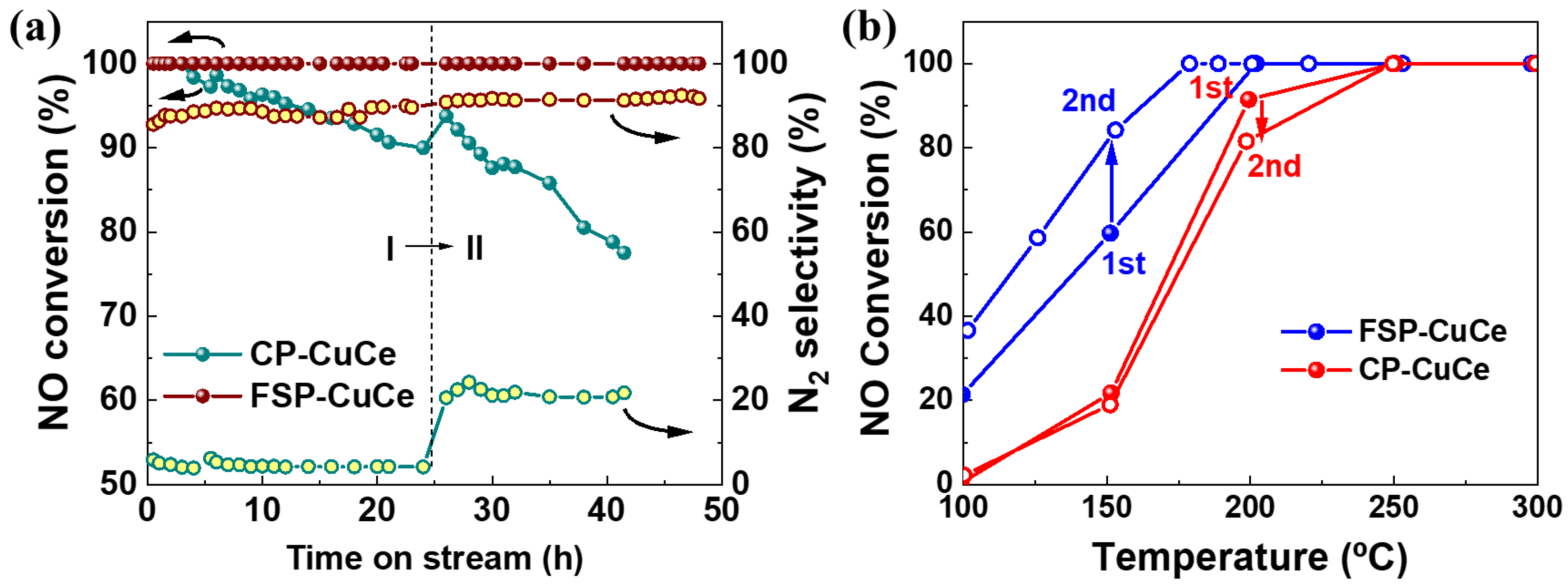



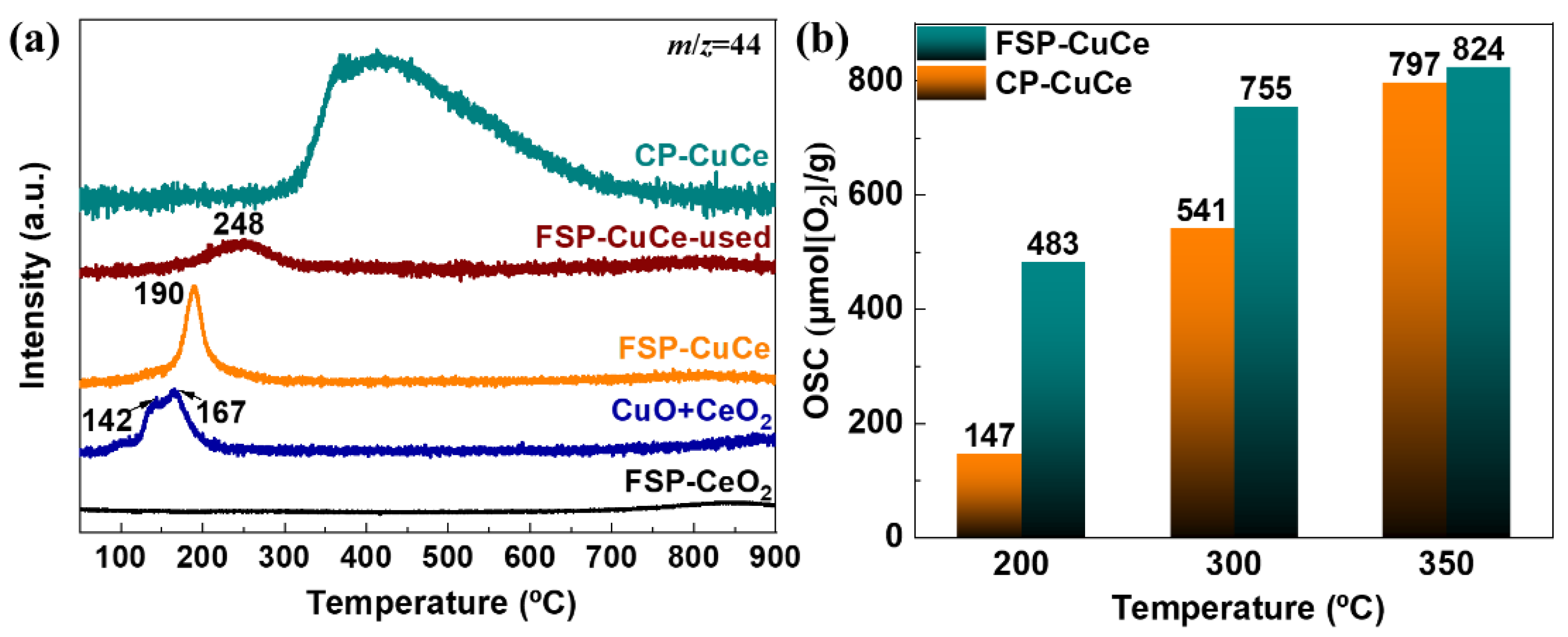
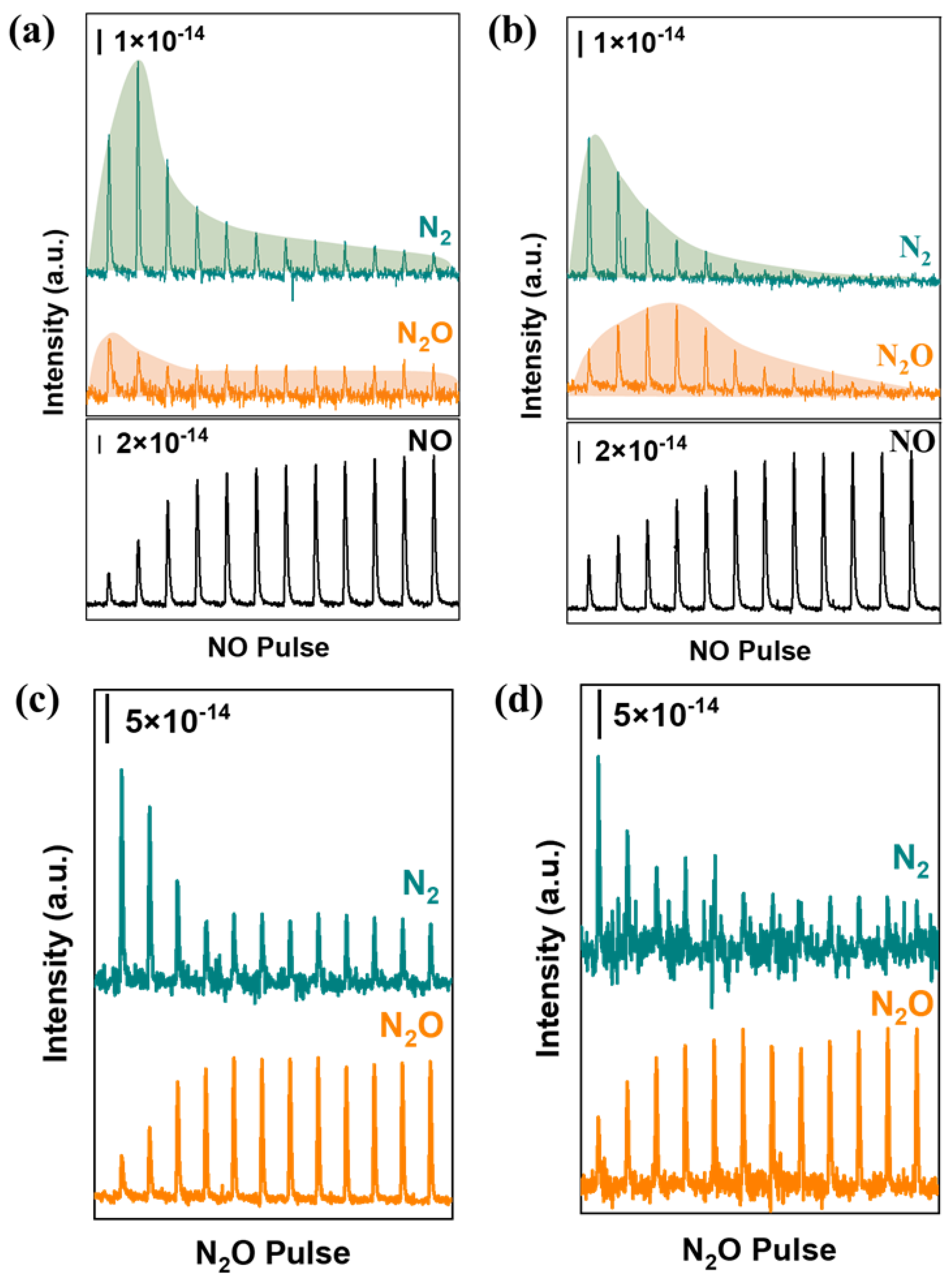
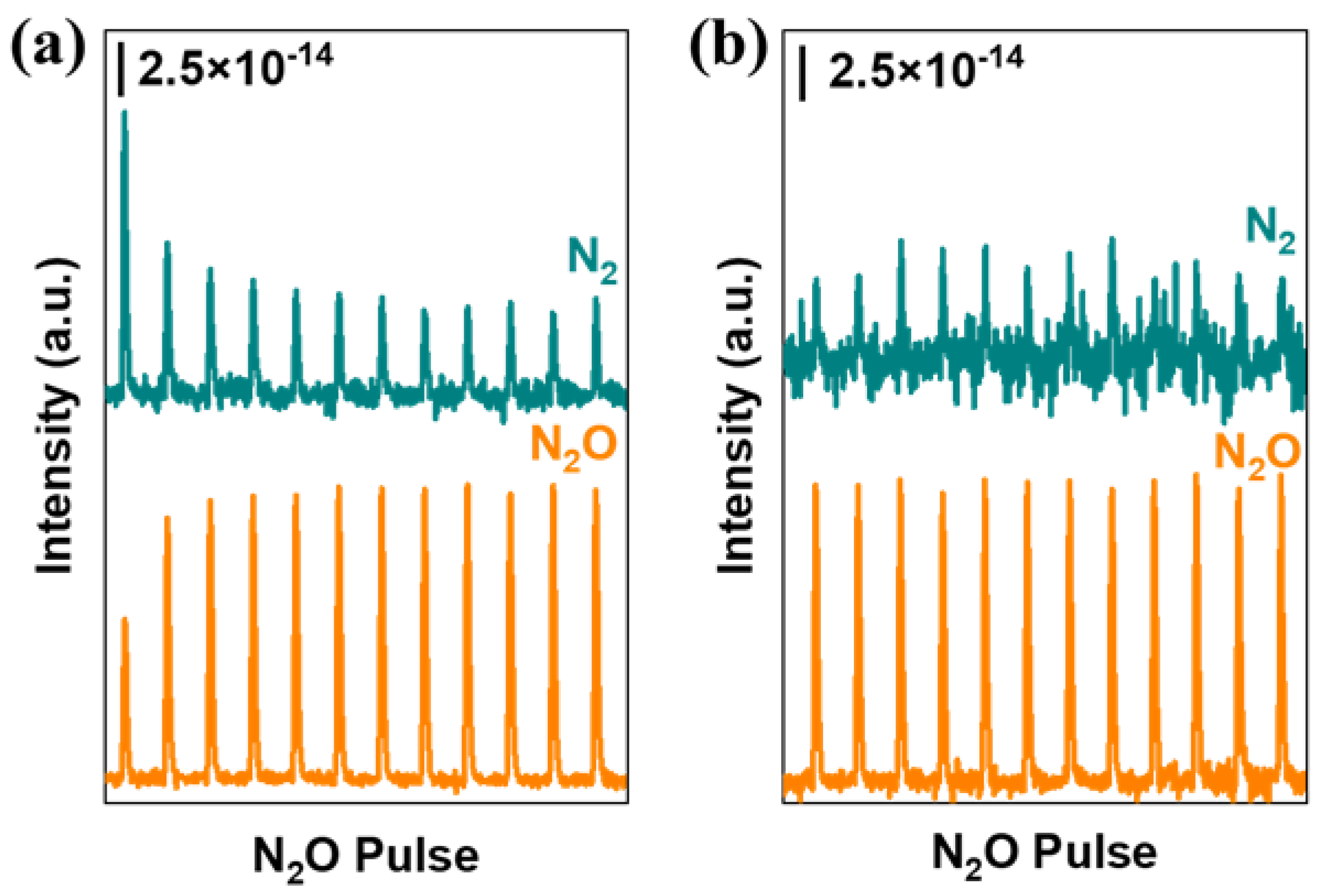
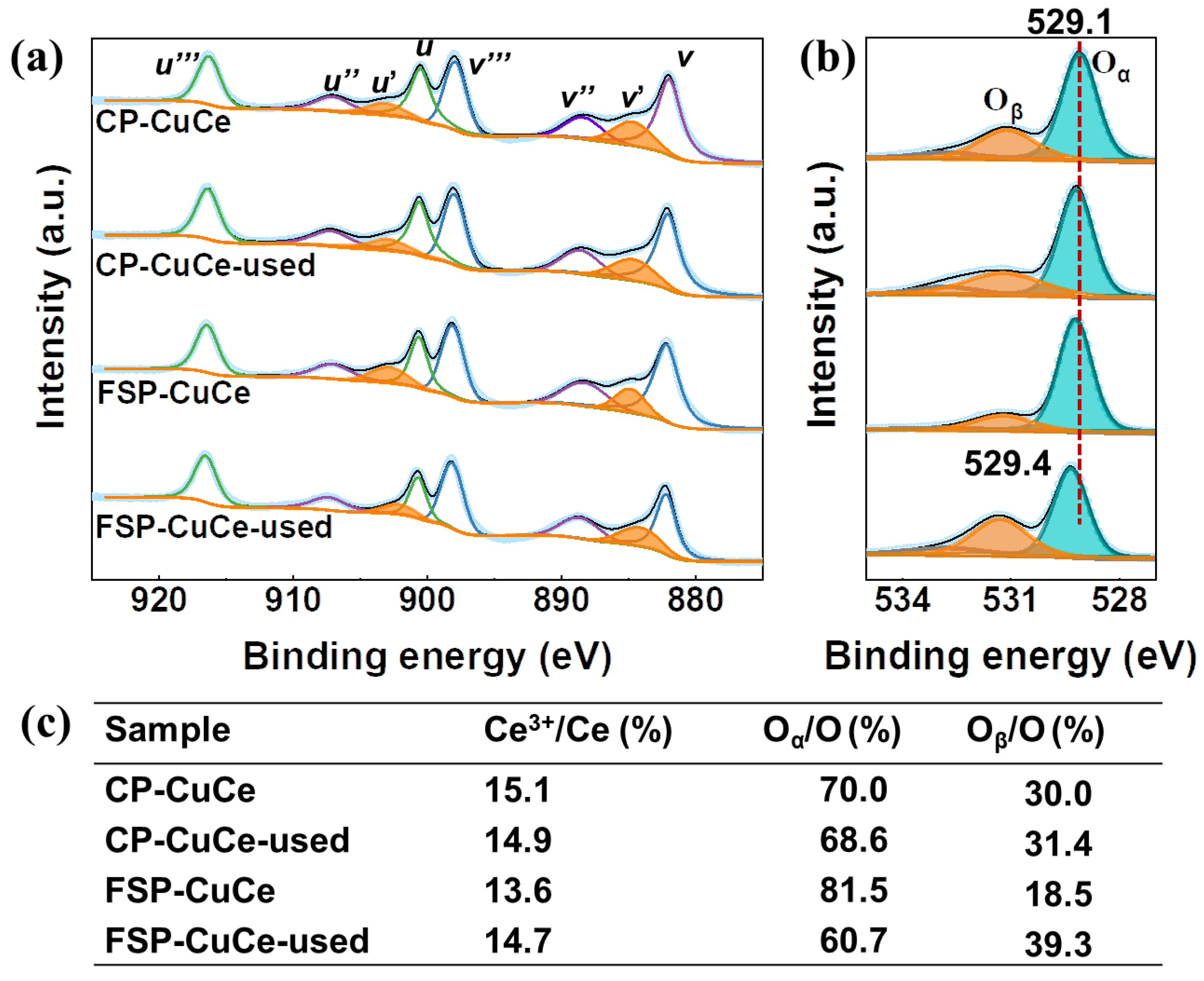

Publisher’s Note: MDPI stays neutral with regard to jurisdictional claims in published maps and institutional affiliations. |
© 2022 by the authors. Licensee MDPI, Basel, Switzerland. This article is an open access article distributed under the terms and conditions of the Creative Commons Attribution (CC BY) license (https://creativecommons.org/licenses/by/4.0/).
Share and Cite
Tong, X.; Yu, J.; Zhang, L.; Sun, J. Fabrication of Stable Cu-Ce Catalyst with Active Interfacial Sites for NOx Elimination by Flame Spray Pyrolysis. Catalysts 2022, 12, 432. https://doi.org/10.3390/catal12040432
Tong X, Yu J, Zhang L, Sun J. Fabrication of Stable Cu-Ce Catalyst with Active Interfacial Sites for NOx Elimination by Flame Spray Pyrolysis. Catalysts. 2022; 12(4):432. https://doi.org/10.3390/catal12040432
Chicago/Turabian StyleTong, Xin, Jiafeng Yu, Ling Zhang, and Jian Sun. 2022. "Fabrication of Stable Cu-Ce Catalyst with Active Interfacial Sites for NOx Elimination by Flame Spray Pyrolysis" Catalysts 12, no. 4: 432. https://doi.org/10.3390/catal12040432
APA StyleTong, X., Yu, J., Zhang, L., & Sun, J. (2022). Fabrication of Stable Cu-Ce Catalyst with Active Interfacial Sites for NOx Elimination by Flame Spray Pyrolysis. Catalysts, 12(4), 432. https://doi.org/10.3390/catal12040432





